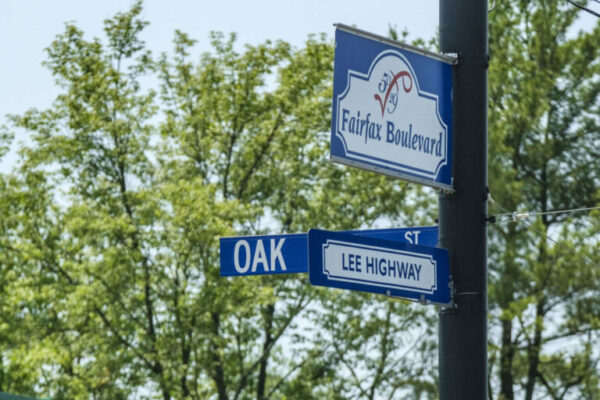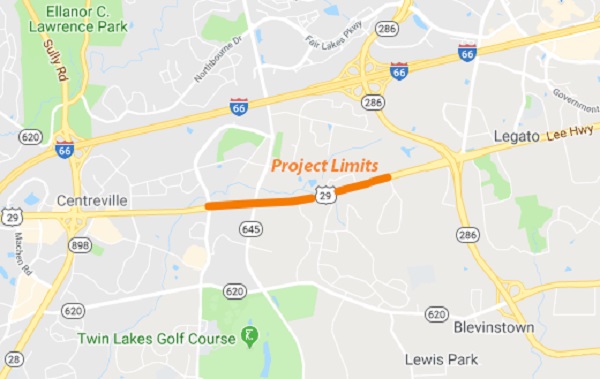
Fairfax County and the Virginia Department of Transportation have kicked off construction to widen a 1.5-mile stretch of Route 29 near Centreville.
Though there will be a ceremonial groundbreaking today (Wednesday), construction on the project began Feb. 9 to add two lanes to the roadway between Union Mill Road and Buckleys Gate Drive.
By the time work finishes in spring 2026, there will be six lanes instead of four on that stretch of road. In addition to the new lanes, the project aims to make improvements to sight distance for drivers and shared-use paths on the roadway.
It will also connect pedestrian and bicycle trails located at the Fairfax County Parkway/West Ox Road interchange.
This work has been on VDOT’s radar for years, with the project first coming to the public at a meeting in October 2018. Notes from a 2019 public hearing say that a 2005 VDOT study “explored the feasibility of providing a continuous 6 lane section from Centreville to the City of Fairfax.”
“Over the past several years, portions of Route 29 have been widened to six lanes (three in each direction) between Centreville and the City of Fairfax,” Mike Murphy, a senior communications specialist at VDOT, wrote in an email to FFXnow.
After this widening, a continuous six-lane section will exist “along the five-mile stretch between Pickwick Road and Shirley Gate Road/Waples Mill Road to improve capacity and safety through the corridor,” Murphy wrote.
The project is removing trees between Stringfellow Road and Meadow Estates Drive on the north side of Route 29. To accommodate that work, residents will need to use alternate routes in place of part of Willow Pond Trail through April 2023.
The estimated cost is $97 million, and those dollars come from four sources: federal, state and local money, plus funding from a I-66 concession fee.
Today’s groundbreaking will be held on the Route 29 service road, near the Brightview Fair Oaks senior living facility. Two members of the Fairfax County Board of Supervisors — Pat Herrity (Springfield) and Kathy Smith (Sully) — plan to attend.
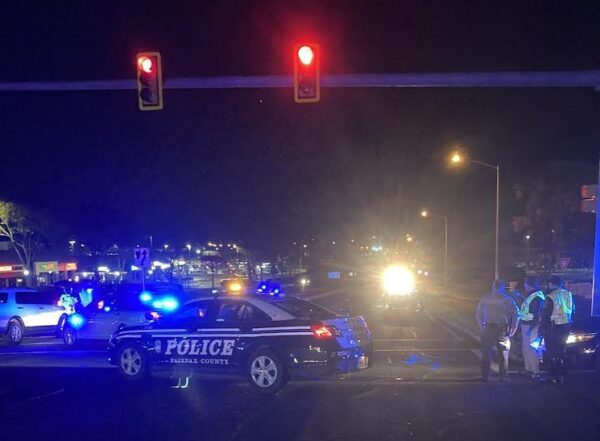
(Updated at 10:25 a.m. on 12/5/2022) A pedestrian died last night after a vehicle hit them on Route 29 (Lee Highway) in Centreville.
The crash occurred at 9:03 p.m. in the Trinity Parkway/Centrewood Drive intersection, which is outside the Centrewood Plaza and Centreville Square shopping centers.
Officers arrived at the scene before 10 p.m., shutting down southbound Lee Highway until around 1:20 a.m., according to Fairfax County Police Department tweets.
The pedestrian, 29-year-old Jacinto Chavez Ramos from Centreville, was using a crosswalk from Trinity Parkway when the driver of a 2021 Toyota Corolla going south on Lee Highway struck him, police say.
“The driver of the Toyota remained at the scene. Rescue personnel responded and pronounced Chavez Ramos deceased,” the FCPD said this afternoon. “Preliminarily, speed and alcohol do not appear to be factors for the driver in the crash. The investigation remains active.”
Crash Reconstruction Unit detectives continue to investigate this crash. Lee Hwy is now open. Follow our blog, https://t.co/lhGv3NDvYs, for updates when available. #FCPD
https://t.co/jGV4Sl90pV— Fairfax County Police (@FairfaxCountyPD) November 29, 2022
At Trinity Parkway, Route 29 has three travel lanes in each direction, plus right and left turn lanes. The intersection has a traffic signal, but there is only a narrow median, and the crosswalks aren’t striped.
Virginia crash data indicates there have been at least three crashes involving pedestrians at that intersection since 2010: one in 2019 and two in 2020, all resulting in injuries but none fatal. The database doesn’t include a crash on Sept. 8, 2016 where a woman suffered critical injuries, according to an NBC4 report at the time.
Nearby, a 25-year-old man died in December 2018 after being hit by a sedan while crossing Centrewood Drive near Centrewood Plaza.
After last night’s crash, Fairfax County’s pedestrian death toll for 2022 has risen to 24 people — the highest it has been in over a decade. That includes 19 deaths on county roads, almost doubling the 11 fatalities recorded by FCPD at this point in 2021.
Photo via VDOT Northern Virginia/Twitter
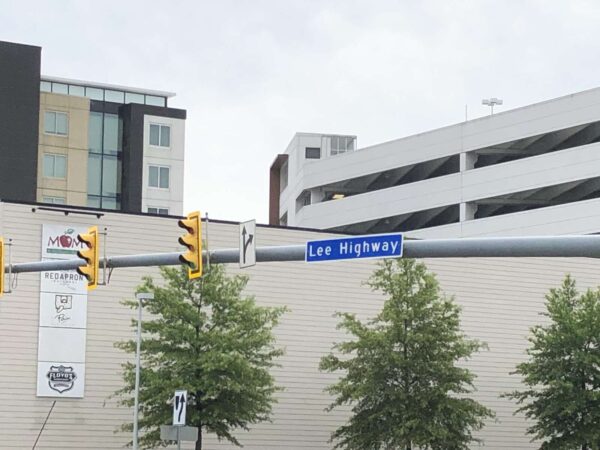
Lee and Lee-Jackson highways may officially no more.
In a 9-1 decision, the Fairfax County Board of Supervisors voted yesterday (Tuesday) to change names of Lee and Lee-Jackson highways to Route 29 and Route 50 respectively.
“This is a necessary and important change for Fairfax County. We will continue to strive to realize our vision of a more equitable One Fairfax,” wrote Fairfax County Board of Supervisors Chairman Jeff McKay in a statement.
The move comes after a yearlong review by the county’s Confederate Names Task Force, which called on renaming the highways. The task force submitted recommendations in December.
Overall, updates to signage is expected to cost roughly $1.4 million, according to a county memo. An additional $1.5 million is estimated for a financial assistance program that would affect businesses and residential units that may be impacted by the name change.
That financial assistance program will be developed in the fall through a formal proposal.
Supervisor Pat Herrity — the board’s lone Republican — voted against the proposal. Officially changing the names will require the approval of the Commonwealth Transportation Board.
The vote comes at the heels of a June decision to change the Lee District’s magisterial name to the Franconia District.
Evoking Confederate generals Robert E. Lee and Stonewall Jackson, the highways were among 150 sites in the county with names whose Confederate origins were confirmed by a 2020 report from the Fairfax County History Commission. Combined, they represent over 20 miles of roadway from Chantilly on the county’s western end to the Falls Church border in the east.
The I-66 Express Lanes connecting Route 29 in Gainsville to Route 28 in Centreville are set to open this weekend, ahead of schedule.
The Virginia Department of Transportation (VDOT) made the announcement Friday (Sept. 2), touting that the opening of the western part of its highway widening project will help congestion on I-66 “sooner than originally planned.”
“We are pleased to join our 66 Express Lanes project partners in opening the first segment of one of Virginia’s largest megaprojects ahead of schedule,” VDOT Commissioner Stephen Brich said in the press release. “By opening the western segment of the new 66 Express Lanes early, we are able to start delivering congestion relief to I-66 travelers sooner than originally planned.”
The 9-mile stretch of road opening this weekend connects the Route 28 interchange in Centreville to Prince William County. Officials said opening that section now will help motorists get used to the new traffic patterns before the rest of the lanes open later this year.
Extending to the Capital Beltway interchange in Dunn Loring, the remaining 13 miles of express lanes are scheduled to open by December.
“This is an important step in opening the new 66 Express Lanes, allowing customers to begin to experience the benefits that the new managed lanes and project enhancements will provide, and helping to ensure a great customer experience when the full corridor opens at the end of the year,” Javier Guiterrez, CEO for the private contractor I-66 Express Mobility Partners, said.
I would watch hours of lane-striping content.
Check out the 35-second mark of this vid for lane striping on the new I-66 Express Lanes near Centreville.https://t.co/kCWBWO19NK pic.twitter.com/oJq0aUNfGB
— Jordan Pascale🎙️ (@JWPascale) September 2, 2022
Overall, the nearly-complete $3.7 billion project mostly centered in Fairfax County will bring widened roads with toll lanes and potentially make room for mass transit projects, while also rebuilding a number of bridges spanning the highway.
There will also be 11 miles of shared-use trails between Fairfax and Prince William counties.
Work began in late 2017 and is expected to finish in mid-2023, though the remaining express lanes will open to traffic a few months prior to that.
I-66 will still have three general traffic, toll-free lanes in the eastbound and westbound directions. The project is adding two high-occupancy toll (HOT) lanes in each direction.
Buses, carpoolers, and motorcyclists will be able to use those lanes for free, while all other motorists will pay a toll based on real-time traffic conditions. The lanes expand the 10 miles of toll lanes between the Beltway and D.C. that opened in 2017.
The project also includes the construction of dedicated on- and off-ramps at Route 234/Sudley Road, Route 28, and Braddock and Walney Roads. Drivers will be able to access the Express Lanes from several general-purpose lanes, including near Route 28.
The I-66 Express Lanes construction is a result of a public-private partnership between VDOT and I-66 Express Mobility Partners, which will maintain and operate the HOT lanes under the 50-year agreement.

A formal vote won’t come for another month, but several Fairfax County supervisors indicated support yesterday (Tuesday) for using routes 29 and 50, respectively, as the official names for the roads known for now as Lee and Lee-Jackson Memorial highways.
The Board of Supervisors directed county staff by a 9-1 vote to prepare a resolution for its next meeting on Sept. 13 endorsing Route 29 and Route 50 as the new names after a year-long review process that included a community task force and public surveys.
While route numbers don’t carry the same symbolism as Arlington County renaming its portion of Lee Highway after abolitionist John Langston, board members expressed hope that the move will reduce the confusion of navigating the county in addition to discarding reminders of the area’s Confederate past.
“Frankly, calling them by the route numbers is what a lot of people already do today voluntarily, so I don’t see this as a heavy lift at all for these two major corridors and I think will chart us a better course moving forward,” Chairman Jeff McKay said.
If the resolution passes, it will go to the Commonwealth Transportation Board, which will have the final say, as required by state law.
Evoking Confederate generals Robert E. Lee and Stonewall Jackson, the highways were among 150 sites in the county with names whose Confederate origins were confirmed by a 2020 report from the Fairfax County History Commission. Combined, they represent over 20 miles of roadway from Chantilly on the county’s western end to the Falls Church border in the east.
Recommending that both roads be renamed, the board-appointed Confederate Names Task Force suggested five alternatives each, including the route numbers, in a report finalized in December 2021.
Surveys of property and business owners in the corridor conducted this past spring found that they preferred the route numbers over the other options, which included following Arlington’s lead with Langston Blvd for Lee Highway.
“I think this is basically as close as we’re going to get to consensus on the names,” said Hunter Mill District Supervisor Walter Alcorn, who chairs the board’s transportation committee. “I think this is a very reasonable and practical way to address the challenge that we’re facing, and I think it’s a big step towards moving away from memorializing that time in history and some of those folks and really updating that.” Read More
A report recommending that Fairfax County rename its portions of Route 29 and Route 50 will go before county leaders tomorrow (Tuesday), even as concerns about the financial impact linger.
Compiled by the 26-person Confederate Names Task Force, the report details the process used to determine that Lee Highway and Lee-Jackson Memorial Highway should get new names and recommends five possible replacements for each road:
Recommended Top Five Alternative Names for Lee Highway (Route 29)
Cardinal Highway, 13 votes
Route/Highway 29, 12 votes
Langston Boulevard/Highway, 6 votes
Lincoln-Douglass Highway, 6 votes
Fairfax Boulevard/Highway, 5 votes
Recommended Top Five Alternative Names for Lee-Jackson Memorial Highway (Route 50)
Little River Turnpike, 16 votes
Unity Highway, 12 votes
Route 50, 6 votes
Fairfax Boulevard, 4 votes
Blue & Gray Highway, 3 votes
Appointed by the Fairfax County Board of Supervisors last July, the task force voted 20-6 on Nov. 30 in favor of changing the name of Lee Highway and 19-6 for Lee-Jackson Memorial.
Task force chair Evelyn Spain will present the final report to the board during its regular meeting tomorrow, which will begin at 9:30 a.m.
“The Board set up this important committee to review the names of two major arterials and now we are eager to hear their report,” Board Chairman Jeff McKay told FFXnow in a statement. “Any decision to change street names is one our Board will take seriously as we consider the report as well as other community input before any decisions are made. I am proud that this Board has a strong record of focusing on racial inequities and advancing our community together.”
The two highways are among 150 landmarks in the county identified as bearing names tied to the Confederacy, according to an inventory that the Fairfax County History Commission presented to local leaders in December 2020.
The commission found that the Virginia General Assembly established Lee Highway in 1922 as a statewide route serving as a national memorial for Confederate Gen. Robert E. Lee.
That same year, the state House and Senate Roads Committee also agreed to rename a section of Little River Turnpike after Lee and fellow Confederate Gen. Thomas Jonathan “Stonewall” Jackson.
The task force recommended that both highways get new names to “accommodate the equity initiatives and growing diversity in Fairfax County,” the report says. It also acknowledges that the changes “will likely be major impositions upon the residences, businesses, and communities” in those corridors.
The group suggests that the Board of Supervisors consider providing financial assistance to those affected, if it ultimately approves the name changes.
The final report features several letters from the task force members who opposed or abstained from voting on the name changes. Objections include:
- A public survey found 23,500 respondents want to keep the names as they are and 16,265 in support of changes
- The cost to make the change, which could total $1 million to $4 million, according to county staff
- Even though the institution of slavery was evil, the name switch “erases history”
“We believe the $1M to $4M required to rename these two roads would be more effectively spent pursuing a community engagement project (e.g. an African-American Heritage Trail, a museum, and/or new historic markers),” the dissenters said, noting that Prince William County is adding to its African American History Trail. “We encourage Fairfax County to pursue similar projects.”
To coincide with Black History Month, the county launched a project last week focused on local Black and African American experiences, including support for students to identify options for new historical markers.
Angela Woolsey contributed to this report.
Two days before Thanksgiving, the 29 Diner was decimated by a fire. The next day, owner John K. Wood got back to work.
“It was a total loss,” Wood told FFXnow of the damage to the iconic, 74-year-old Fairfax City eatery. “But there’s nothing to be sorry about. It’s time to celebrate what this diner means to the community. I’m going to be here every day that I can — rain, sleet, snow — to watch the rebirth of the 29 Diner.”
Firefighters got a call around 6 p.m. on Nov. 23 about an explosion in the back of the building, WJLA reported. When crews arrived, a fire had spread from a storage room where chemicals were being stored to the kitchen across the way.
“It was a chemical fire that reached about 700 degrees,” said Wood, a Robinson High School graduate who has owned the diner since 2014.
Thankfully, no one was in the building at the time, but the fire rendered the kitchen completely unusable. Wood estimates it could take six months for the kitchen to be restored so the diner can reopen.
He’s already getting significant help from the community to do just that. A GoFundMe campaign set up to help Wood rebuild and support the employees that have lost their jobs has amassed over $54,000 in just a week’s time.
“I’m on the wings of the community and I feel the love,” Wood said.
A cozy spot to get a short stack and two eggs over easy, 29 Diner is also a historic landmark. In 1992, it was placed on the National Register of Historic Places for being a “uniquely American form of roadside architecture.”
The pre-assembled metal, glass, and double-wide diner was considered the “Cadillac of diners,” Wood says, when it emerged in 1947. The building was manufactured in New Jersey and purchased by original owner D.T. “Bill” Glascock, who placed it along Fairfax Boulevard, which was called Lee Highway then, like Route 29 still is (for now) in Fairfax County.
Wood reveals a little-known secret about the restaurant: a 1,500 square-foot basement, the dimensions of a good-sized townhouse, runs the entire length of the diner.
29 Diner grew with the region, becoming a hub of community in Fairfax. It did go through several owners, including Fredy and Virginia Guevara, who was a server there in the 1960s. When the couple retired, Wood took over.
“You step into that diner, and it just takes you back to when you were 9 years old and you got your first milkshake,” Wood told The Washington Post when he became the owner in 2014.
Wood has been a proud steward ever since. Open 24 hours, six days a week, the diner has become a headquarters of sorts for a number of charitable endeavors, raising money for causes from feeding those in need to supporting families with cancer and veteran suicide prevention.
Not even a destructive fire can dim Wood’s perpetual optimism and commitment to giving back.
“This is going to give us a chance to remodel, in the way the Lord wanted us to have,” he said.”We are going to set up a more inclusive kitchen, [better] wheelchair access, and help disabled veterans.”
Wood is planning a number of events in the coming weeks to help raise money, including runs and a motorcycle rally.
He says a big chunk of donations will also go toward providing for his employees and their families while they wait for the diner to reopen.
Rich Berkwitz, who set up the GoFundMe campaign, appreciates everything Wood has done for the diner and community. A teacher at Mark Twain Middle School in Alexandria and an assistant wrestling coach at John Lewis High School, he says he eats at 29 Diner “pretty much every week” because “it feels like home.”
“I’m so happy that the community is backing him as much as he’s back to the community,” he said. “He’s just so giving.”
It’s unlikely that 29 Diner will reopen prior to June 2022, but Wood has faith in the future.
“It’s going to come back better than it was,” he said. “That wasn’t a fire. That was the Lord paying a visit to the 29 Diner.”
A task force of nearly 30 people has recommended renaming two highways in Fairfax County, following concerns that their invocation of the Confederacy runs counter to the county’s goal of creating an inclusive environment.
After months of meetings and debate, the Confederate Names Task Force voted 20-6 yesterday (Tuesday) in favor of a change for Lee Highway (also known as Route 29) and 19-6 for Lee-Jackson Memorial Highway (Route 50), with at-large member Tim Thompson abstaining.
The recommendation is just one step in the renaming process. It came after the task force gathered public input with a series of listening sessions and an online survey.
The Fairfax County Board of Supervisors and state’s Commonwealth Transportation Board would have to sign off on any name changes.
Some committee members argued that renaming the highways would “erase history.” Jenee Lindner, one of four Springfield District representatives, said doing so was wrong.
“If we’re going to move forward, let’s eradicate that term, ‘erasing history.’ It’s not true. Personally, we’re erasing stupidity and injustice and immorality,” Pastor Paul Sheppard from Providence District countered.
Dranesville District representative Barbara Glakas, a retired teacher from Fairfax County Public Schools, said if Confederate leaders had their way, the U.S. might look more like Europe, with fragmented countries, and slavery might have continued for much longer.
The task force’s votes diverged from the results of the public survey, where 23,500 respondents said they support keeping the names as they are, and 16,265 called for changing them.
“We can’t just ignore that opinion, whether you agree with it or not,” said Braddock District’s Robert Floyd, who voted against the recommendations and was one of a handful of people who tuned into the meeting remotely.
The survey was more designed to be a pulse check than as a poll that met scientific sampling standards and could be representative of the entire population. It had a mechanism to prevent people from taking it repeatedly, but it only blocked Internet Protocol (IP) addresses, meaning people could still participate multiple times, skewing results.
For respondents who wanted the highways to be renamed, many people proposed using Route 29 and Route 50, which are already used on maps.
Sully District committee member Marvin Powell said society renames things all the time and the county needs to think of the citizens of today and tomorrow.
The committee also discussed how families’ properties were taken by eminent domain for the roads in question. Sheppard said his family was affected and joked one road could have originally been named after his family.
The Board of Supervisors appointed the task force in July after the Fairfax County History Commission compiled an inventory of streets, monuments, and public places with names tied to the Confederacy. It found “approximately 157 assets, including parks, within the County that bear confirmed Confederate associated names,” the December 2020 report said.
Michael Champness, an at-large member of the Confederate Names Task Force, said before the votes that changing the two highway names sends an important message, but the county doesn’t necessarily need to rename all of those landmarks.
“We might be in a good position to maybe call a truce after this,” he said, before voting “yes” on each motion. “I think it’s very important to change these names because it’s important to be heard. It’s important for action to take place…but I don’t think we need to try and change every street name.”
The task force is scheduled to vote on Dec. 13 on alternative names to recommend to the Board of Supervisors, which could schedule a public hearing and act on the recommendations in early 2022.
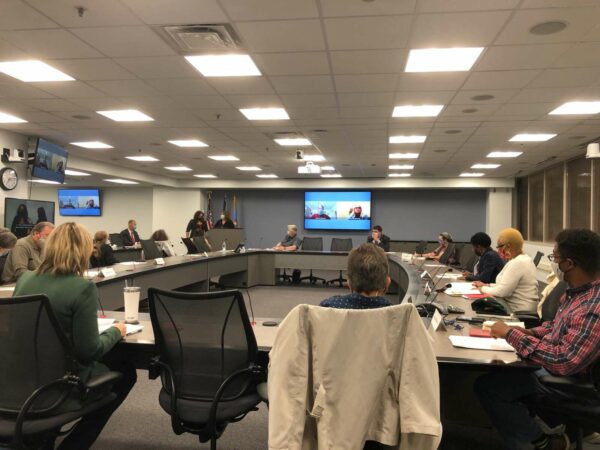
Though they have cropped up with increasing regularity both locally and nationally in recent years, conversations about how to handle symbolic reminders of the Confederacy remain as emotionally charged as ever.
That was evident in the most recent meeting of Fairfax County’s Confederate Names Task Force, which has been charged with determining whether the county should rename Lee and Lee-Jackson Memorial highways.
“We have a nice taste of different people from different parts of Fairfax that want to weigh in,” task force chair Evelyn Spain said. “We value all of their opinions on whether this end result comes to change the name or not change the name of Fairfax streets.”
The two-hour meeting at the Fairfax County Government Center on Monday (Oct. 18) followed the launch of a community survey last week. Postcards advertising the survey are expected to roll out to residents across the county starting this weekend.
Also accepting public comments by email, phone, mail, and at four upcoming listening sessions, the task force will use the input to inform its recommendation to the Fairfax County Board of Supervisors.
“I don’t want people to be back here in 30 years because we made a wrong decision,” one member said.
The Financial Cost of Changing the Names
Changing the names of both highways could cost Fairfax County anywhere from $1 million to $4 million, Fairfax County Department of Transportation Director Tom Biesiadny told the task force.
According to FCDOT, there are 171 Lee Highway signs along the county’s 14.1-mile stretch of Route 29 and 55 Lee-Jackson Memorial Highway signs on 8.4 miles of Route 50.
The cost varies depending on each kind of sign, particularly ones on traffic light mast arms or other overhead structures. If a new street name is longer than the existing one, replacing the signs will require more work due to the added weight, Biesiadny explained.
“What we’re going to replace it with does matter,” he said.
Biesiadny also reported that, based on estimates from neighboring localities that have adopted new highway names, a name change would cost businesses about $500 each to update their address on signs, stationary, and legal documents, among other possible expenses.
Other jurisdictions are looking at providing grants to cover businesses’ costs, according to Biesiadny, who noted that the county would need to conduct a survey of businesses to get a more precise estimate.
What’s in a (Street) Name?
For the task force, however, the question of whether to rename the highways hinges less on money than on what the names say about a community’s values and identity.
In a facilitator-led discussion on street name criteria, several members cited inclusivity and reflecting Fairfax County’s increasingly diverse population as key concerns. Read More
For anyone who feels strongly about whether or not Lee Highway and Lee-Jackson Memorial Highway should continue to bear those names, the time to share that opinion has arrived.
The Fairfax County Confederate Names Task Force launched a survey yesterday (Thursday), kicking off the community engagement phase of its review of whether to rename the highways.
Open until Nov. 12, the survey is available in English, Spanish, Arabic, Farsi, Korean, and Vietnamese. Chinese and Urdu versions will be coming soon, and print copies will be available at county libraries and district supervisor offices starting next Wednesday (Oct. 20), according to the task force’s website.
According to the news release, the task force will send out a countywide mailer to all residents later this month encouraging them to weigh in on the issue, and four public meetings — three in person, one virtual — have been scheduled through early November:
- Thursday, Oct. 28: Providence Community Center, 3001 Vaden Drive, Fairfax, 7-8:30 p.m.
- Saturday, Oct. 30: Fairfax County Government Center, 12000 Government Center Parkway, 10-11:30 a.m.
- Monday, Nov. 1: via WebEx, 7-8:30 p.m.
- Thursday, Nov. 4: Sully District Governmental Center, 4900 Stonecroft Boulevard, Chantilly, 7-8:30 p.m.
Comments can also be sent to the task force by email, phone (703-877-5600), and regular mail (Fairfax County Department of Transportation, 4050 Legato Road, Suite 400, Fairfax, VA 22033).
“Symbols matter and we want our community to feel welcome and reflect our values,” Fairfax County Board of Supervisors Chairman Jeff McKay said. “Community feedback is a key part of the renaming of Lee and Lee Jackson Memorial Highways process and will determine our next steps forward. There are multiple ways to offer feedback including a survey and community listening sessions. I encourage everyone who can to join the discussion.”
The Board of Supervisors appointed the 30-member task force in July after getting a report from the county’s history commission that identified more than 26,000 streets and other local landmarks bearing names associated with the Confederacy.
The Fairfax County History Commission narrowed its inventory down to 150 sites named after well-known Confederate figures, with Lee and Lee-Jackson highways among the most prominent.
The county’s portion of Route 29 spans 14.11 miles from Centreville to Falls Church and was named after Confederate general Robert E. Lee in 1919, according to the task force. Lee and fellow general Stonewall Jackson became the namesakes for the 8.43-mile stretch of Route 50 from Loudoun County to the City of Fairfax in 1922.
While those monikers have stuck for around a century now, nationwide efforts to remove names linked to the Confederacy or slavery from public places have gained momentum in recent years. Fairfax County Public Schools alone has renamed three buildings in the past four years.
Neighboring Arlington County renamed its section of Route 29 this past summer, replacing Lee’s name with that of abolitionist John M. Langston, Virginia’s first Congressional representative of color.
Expected to present a recommendation on whether to rename the roadways to the Board of Supervisors in December, the Confederate Names Task Force has been meeting on a regular basis since Aug. 16. The agenda for its upcoming meeting on Monday (Oct. 18) includes a staff briefing on the cost implications of a name change and a discussion of criteria for street names.
If the task force recommends changing the names, it will then offer up to five possible new names for each road, and after holding a public hearing, the Board of Supervisors will vote on the recommendation, potentially early next year. The name changes would then have to get state approval and go through the county budget process to cover the costs.


